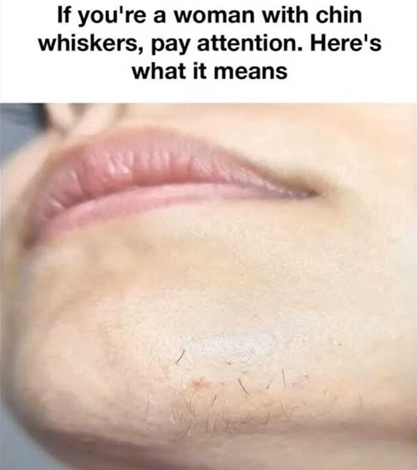
Exploring the Natural Causes of Chin Hair Growth
Chin hair, like all other body hair, develops through a natural and cyclical process known as the hair growth cycle. Although it might seem like a small detail of human biology, this process is actually quite complex and fascinating, influenced by hormones, genetics, and individual differences. Just like scalp or eyebrow hair, each chin hair grows from a tiny structure beneath the skin called a hair follicle. Each follicle operates independently, meaning not all hairs grow or shed at the same time — which is why you’ll always notice some new hairs appearing even as others fall out naturally.
The Three Phases of Hair Growth. The hair growth cycle is typically divided into three main stages, each serving a distinct purpose in the development and renewal of hair. 1)Anagen Phase (Growth Stage)
This is the active growth period, when the hair is nourished by blood vessels connected to the base of the follicle. Cells within the root rapidly divide, pushing the hair shaft upward and out through the skin. For most body hairs, this phase can last anywhere from a few weeks to a few months, depending on genetics and hormone levels.
2)Catagen Phase (Transition Stage)
Following the growth phase, the follicle enters a brief transition period lasting about two to three weeks. During this stage, the hair stops growing and gradually detaches from its blood supply. The follicle itself begins to shrink, preparing for the next cycle.
3)Telogen Phase (Resting and Shedding Stage)
The final stage is the resting phase, where the old hair remains in place for several weeks before eventually shedding to make room for new growth. This is a completely natural process — shedding doesn’t mean hair loss, but rather a renewal of the cycle that keeps the follicle healthy and active.
Why Growth Rates Differ
The duration of each phase can vary widely from person to person. Some individuals may notice only a few fine or light hairs on the chin, while others may experience darker, thicker, or faster-growing hair. These differences are perfectly normal and largely influenced by genetics, age, hormones, and even ethnicity. For example, as people age or experience hormonal changes — such as during puberty, pregnancy, or menopause — they may notice shifts in hair density or texture on certain parts of the body, including the chin.
The Role of Hormones: Understanding Androgens
One of the key biological influences behind chin hair growth is a group of hormones known as androgens. These include testosterone and its related compounds, which are present in both men and women but in different amounts. In males, androgens are responsible for the development of facial hair, deeper voices, and other secondary sexual characteristics. In females, these hormones are present in smaller quantities but still play an important role in regulating body functions, including hair growth patterns. When androgen levels rise, or when the body’s hair follicles become more sensitive to these hormones, it can lead to an increase in chin or facial hair. This can occur naturally due to genetic predisposition, aging, or certain hormonal conditions such as polycystic ovary syndrome (PCOS). However, in most cases, it is simply a harmless variation of normal physiology.
When Chin Hair Growth Increases
Some people may notice that chin hair becomes more noticeable with age, particularly in women after menopause. This is because estrogen levels decrease while androgen levels remain relatively stable, creating a hormonal shift that allows certain hair follicles to become more active. In other cases, lifestyle factors such as stress, diet, or medication can subtly influence hormone balance, leading to changes in where and how quickly hair grows. It’s important to remember that these variations are common and natural, and do not necessarily indicate a health problem.
A Normal Part of Being Human
Overall, chin hair growth is a completely natural process — one that reflects the intricate balance of hormones and genetics within the human body. While cultural beauty standards often highlight or stigmatize facial hair, the truth is that nearly everyone has some degree of growth, whether visible or fine and light. Understanding this process helps people feel more comfortable and less self-conscious about these changes. Whether someone chooses to remove, trim, or embrace their chin hair is entirely a personal choice, guided by comfort, style, and individual preference.
As Charli Worgan — a body-positivity advocate — once expressed, “The more we understand what’s natural, the less power judgment holds.” And that’s especially true when it comes to something as normal and human as the hair that grows on our skin. So, the next time you notice a new chin hair appearing, remember: it’s not a flaw or a sign of imbalance — it’s simply your body doing what it’s designed to do.




